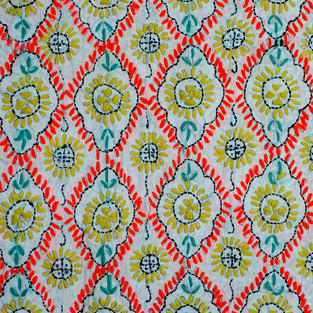
FABRICS
BLOCK PRINT
It is a process of printing motifs performed on cotton, linen or silk, by means of engraved wooden blocks.
It is the first, simplest and slowest of all textile printing methods - a process capable of producing highly artistic results, some of which can only be achieved through this medium.
In India this ancient tradition is still maintained mainly in the state of Rajasthan .
The fabric is then used for the home or for clothing.









KHADI
THE VALUE OF HAND-WOVEN SILK AND COTTON
Hand loom or electric?
It is difficult to understand at first glance how a certain fabric was worked. The difference exists and is immediately obvious even to the less experienced touch: silk or cotton woven by hand have a pleasantly irregular texture (this is their beauty) and a particularly soft (almost sensual) hand, immediately perceptible even on the skin once the head.
The handwork immediately brings out the patience, the effort, the sensitivity of the man who made that fabric:
the Khadi in silk or cotton that you will wear contains all the energy, like that of the person who prints with wooden stamps (“block print”) manually, and also that of the tailor who makes the garment. A skilled craftsman can weave a maximum of 3 meters per day. Seemingly simple and poor, in reality precious, soft and lasting:
the garments thus obtained are in fact destined to last forever. For people who appreciate quality, refinement and style.
A project signed by Margo to keep alive the tradition of manual work of man,
in India and throughout the world.
Khadi , the traditional fabric prized and revered by all Indians:
a real textile jewel made with hand loom in the villages, the result of expert and patient hands.



KHANTA - GUDRI
Khanta or Gudri is an embroidery originating from the state of Bengal.
It is made by overlapping two or more layers of fabric (like a quilt) with running stitch.
The designs are equally visible on both sides and therefore both usable.
Traditionally, worn-out clothes and saris were stacked together and sewn into quilts.
Rural Bengali women still do it in cotton or silk saris.
With this method, shawls, quilts, jackets, clothing items and bags are made.
Themes include flowers, geometric designs, humans and mythological figures.
They are true works of popular art.



EMBROIDERY
Secular techniques and craft traditions: it is the story of all time, of millennial India as well as of India of the twenty-first century. Spreading through color, fibers and fabrics is an integral part of the anthropology of its costume and the tradition of its culture.
India is the country of inimitable fabrics: sumptuous or poor, with esoteric symbols, they accompany every Indian throughout his life. Important prints with elaborate motifs, such as the “boteh” ones (the classic cashmere / paisley design), also shown on fabrics of little value; embroidery as works of art.
Amazing workmanship, precious applications, stitching and often metallic and therefore dazzling inserts.
Each state or region has its own particular embroideries, performed by women in the villages, popular works of art that fortunately continue to live even today.





